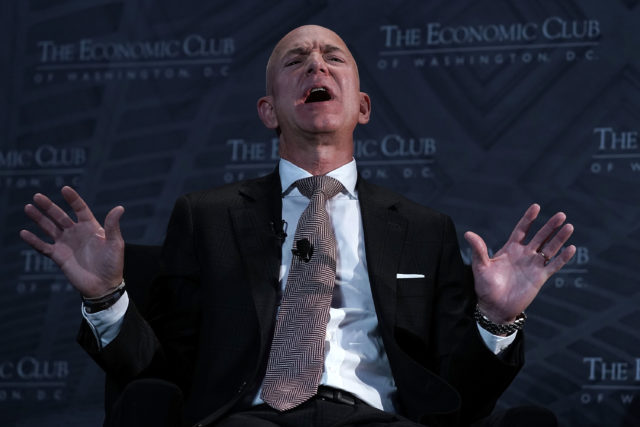The Amazon Music Boycott Is Growing
On Tuesday, November 26, JPEGMAFIA became the latest musician to withdraw from the lineup of Intersect, a new Las Vegas music festival funded and presented by Amazon Web Services. Representatives of the celebrated art-rapper did not provide a reason for his decision to SPIN, but it comes against the backdrop of a rising tide of protest by independent musicians against Amazon for the tech behemoth’s contracts with Palantir, a data-mining company that provides software for federal Immigration and Customs Enforcement.
In October, prompted by the announcement of Intersect, more than 1,000 musicians signed a pledge not to participate in Amazon-sponsored events or exclusive Amazon partnerships until the company terminates its relationship with Palantir, among other demands. Organizers of the campaign, dubbed No Music for ICE, escalated their tactics this week, with a call for participating musicians to also remove their catalogs from Amazon Music Unlimited, the company’s music streaming service. Acclaimed indie bands Deerhoof, Downtown Boys, Speedy Ortiz, and Told Slant are among those who have already directed distributors to pull their albums from the platform. Signees of the initial boycott of Amazon events include Fugazi’s Guy Picciotto, Vivian Girls, Ted Leo, and Car Seat Headrest.
“It is time to say NO to ICE and the tech companies that power it, like Amazon,” the organizers wrote in an open letter on Sunday. “A mass, collective takedown is an escalation, another step in musicians acting in solidarity with the numerous groups across the country protesting to shut down ICE and end family separations, deportations, and other horrors.”
Amazon Web Services, the company’s cloud computing division, hosts a whopping portion of the internet on its servers, including Netflix, Lyft, and AirBnB. AWS’s client list also includes Palantir, a largely secretive company co-founded by the notorious billionaire venture capitalist Peter Thiel, which develops the case management software that ICE uses to target immigrants, including parents of unaccompanied minors, for criminal prosecution. In 2018, ICE held a daily average of 44,631 people in detention, the highest number in the agency’s 16-year history.
Chicago-based dance music producer and DJ The Black Madonna was the first artist to withdraw from Intersect after the lineup was unveiled. She credited her decision to Amazon’s indirect ties with ICE, and alleged that she had not been informed that Intersect was Amazon-affiliated when she signed on to perform, a claim Amazon representatives have denied. Representatives for seven artists still on the Intersect bill declined to comment on their involvement, or whether they had been informed of Amazon’s involvement.
Organizers told SPIN that No Music for ICE was inspired by similar campaigns by tech workers and immigrant rights organizations, and also by online discourse about Intersect after the lineup was announced. “It seemed to me a bit wrong that so much of the attention was going on artists, you know, calling them out, rather than going towards why it is that musicians shouldn’t want to work with Amazon, and how many of us don’t, and sort of formally voicing that,” Speedy Ortiz guitarist and bandleader Sadie Dupuis, an organizer of the campaign, told SPIN.
Employees at Amazon, Microsoft, and Google have organized petitions in the past year demanding that their companies reject existing and prospective contracts with both ICE itself and third party firms like Palantir that develop the agency’s software. The Seattle software company Chef announced in September that it would not renew an ICE contract after employees protested. And in a precedent for the artist-organizers of No Music for ICE, two major independent comics festivals, Bethesda’s Small Press Expo and the Toronto Comics Art Festival, dropped the Amazon-owned comics distribution platform ComiXology as a sponsor after nearly 200 artists and industry workers published an open letter criticizing Amazon’s relationship with Palantir. (Both festivals declined to comment.)
Kate M., a tech organizer and musician who helped organize No Music for ICE (and declined to share her last name), said that artists in the streaming era share common ground with tech workers. “It’s important to realize that, as musicians, if we are taking paychecks from Amazon, we are tech workers too, and have the power to withhold our labor and affect Amazon’s bottom line,” she told SPIN. “This seems like a logical moment for us to start building our movement.”
The open letter includes step-by-step instructions for removing music from Amazon. It also acknowledges the cost of taking a stand, claiming that, for major rock acts, the platform accounts for around four percent of an album’s first-week streams. It’s a relatively small share compared to the dominance of Apple and Spotify in the music market, but not immaterial. Still, this dynamic makes it easier for a musician to withhold work from Amazon than it might be for, say, a cartoonist. “Not every author can afford to extract themselves from Amazon completely,” Michael DeForge, an artist who helped organize the cartoonist campaign, told SPIN.
Three labels—Philadelphia’s Get Better, London’s Damnably, and Barcelona’s Sidefunk—said they have issued takedowns to Amazon for their entire roster. Amazon did not respond to multiple requests for comment.
If you would like to share any interesting information, email me at tosten.burks@spin.com.
@tostenbur






